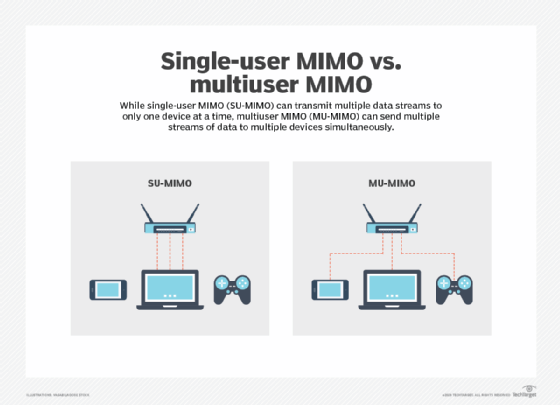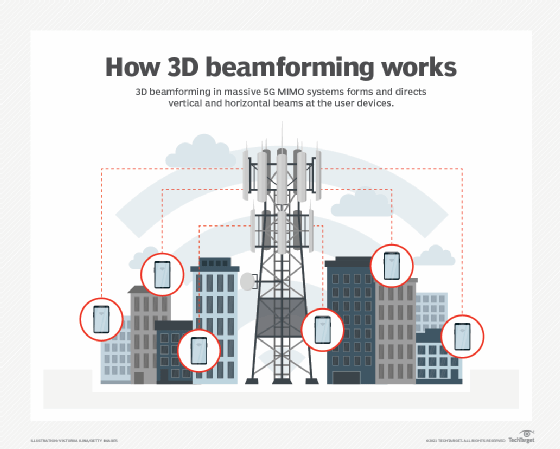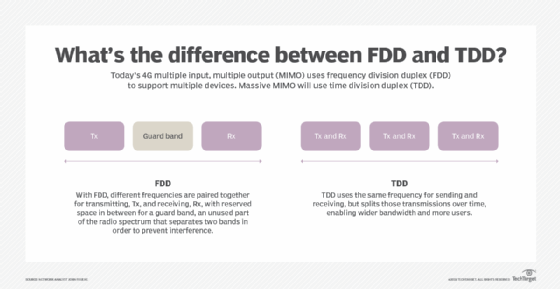What is MIMO (multiple input, multiple output)?
MIMO (multiple input, multiple output) is an antenna technology for wireless communications in which multiple antennas are used at both the source (transmitter) and the destination (receiver). The antennas at each end of the communications circuit are combined to minimize errors, optimize data speed and improve the capacity of radio transmissions by enabling data to travel over many signal paths at the same time.
MIMO's primary advantages
Creating multiple versions of the same signal provides more opportunities for the data to reach the receiving antenna without being affected by fading, which increases the signal-to-noise ratio (SNR) error rate. By boosting the capacity of radio frequency (RF) systems, MIMO creates a more stable connection and less congestion.
The ability of MIMO to provide excellent signal strength, even in challenging conditions, makes it an optimal choice for transmitting high-quality video and audio signals.
In its various configurations, MIMO has a number of advantages over other antenna technologies like MISO (multiple input, single output) and SIMO (single input, multiple output):
- Stronger signals. MIMO bounces and reflects signals, so a user device doesn't need to be in a clear line of sight.
- Greater throughput. Video and other large-scale content travels more quickly because MIMO supports greater throughput.
- Improved visual and auditory quality. MIMO delivers many data streams simultaneously, which also decreases the chance of lost data packets.
The importance of MIMO for users
MIMO is important for users because it addresses fading, a problem that's common with point-to-point radio transmission. Fading, which can result in signal fragments getting distorted (selective fading) or lost (nonselective fading), affects signal quality and causes transmission errors. MIMO receiving antennas process signal fragments, while accounting for any noise or interference. Also, multiple smart transmitters and receivers are used along with spatial diversity technology to minimize fading, improve signal range and ensure better quality and more reliable signals.
MIMO technology is used for Wi-Fi networks and cellular fourth-generation wireless (4G), Long-Term Evolution (LTE) and 5G technology in a wide range of markets, including law enforcement, broadcast TV production, government, and defense. It can also be used in wireless local area networks (WLANs) and is supported by all wireless products with 802.11n.
MIMO is often used for high-bandwidth communications where it's important not to have interference from microwave or RF systems. For example, it's frequently used by first responders who can't always rely on cell networks during a disaster or a power outage or when a cell network is overloaded.
Wi-Fi 6 -- also known as 802.11ax -- raised the bar for wireless connectivity by introducing several new technologies to help eliminate the limitations associated with adding more Wi-Fi devices to a network. Wi-Fi 7 was officially released in January 2024.
History of MIMO
Before MIMO, there were other types of advanced antenna technology with different configurations -- most commonly, MISO and SIMO. MIMO builds on these technologies to improve signal performance and quality.
Research into MIMO began in the 1970s. However, it wasn't until the 1990s when actual work began on developing MIMO systems. The initial goal was to find a way to limit signal degradation. The availability of increased processing power helped accelerate the development of MIMO systems that could use more signal paths to carry data, improve channel capacity and improve signal strength and quality.
In 2009, the 3rd Generation Partnership Project (3GPP) added MIMO with Release 8 of the Mobile Broadband Standard. This release introduced the MIMO multiple antenna scheme and demonstrated that peak data rates of up to 300 megabits per second (Mbps) were possible in downlink and up to 75 Mbps in uplink with 4×4 MIMO. It also introduced LTE for the first time.
How does MIMO work?
The basic premise of MIMO technology is that it uses multiple antennas to transmit and receive the same signal, and it applies the principle of space diversity -- which means that different versions of the same data stream are generated. Also, the receivers collect a diverse range of signals using a spatial equalizer and combine them after performing demodulation and decoding. The combination of signals is close to the original signal, meaning error is low and data transmission reliability is high.
MIMO also uses spatial multiplexing to divide the signal data into multiple data streams. These streams are then transmitted on different antennas, which are independent of each other and improve the transmission rate and signal quality at the receiver end.
LTE applications of MIMO
MIMO is one of the most common forms of wireless, and it played a key role in the deployment of LTE and the wireless broadband technology standard WiMAX. LTE uses MIMO and orthogonal frequency-division multiplexing (OFDM) to increase speeds up to 100 Mbps and beyond. These rates are double what was offered in previous 802.11a Wi-Fi. LTE uses MIMO for transmit diversity, spatial multiplexing (to transmit spatially separated independent channels), and single-user and multiuser systems.
MIMO in LTE enables more reliable transmission of data, while also increasing data rates. It separates the data into individual streams before transmission. During transmission, the data and reference signals travel through the air to a receiver that will already be familiar with these signals, which helps the receiver with channel estimation.
SU-MIMO vs. MU-MIMO
There are two primary types of MIMO: SU-MIMO and MU-MIMO -- single-user and multiuser MIMO, respectively. In SU-MIMO systems, data streams can only interact with one device on the network at a time.
Issues arise with SU-MIMO when many users attempt to use the network simultaneously. If one person is uploading a video and another is conferencing, the data stream will choke, causing latency, or delays, to skyrocket. On the other end of the spectrum, MU-MIMO has the advantage of being able to stream multiple data sets to multiple devices at a time. This facilitates multi-user communication and significantly improves throughput. MU-MIMO systems, therefore, outperform SU-MIMO.
There are various possible configurations for these MIMO systems, with 2x2, 4x4, 6x6 and 8x8 being the most common. 5G massive systems manipulate these configurations to enable extensive network capacity.

MIMO and beamforming
Beamforming is an RF management technique that maximizes the signal power at the receiver by focusing broadcast data to specific users instead of a large area. With 5G, 3D beamforming forms and directs vertical and horizontal beams at the user. These can reach devices even if they're at the top of a high-rise, for example. The beams prevent interference with other wireless signals and stay with users as they move throughout a given area.

MIMO and 5G massive systems
MIMO continues to upgrade and grow through its use in massive new applications, as the wireless industry works to accommodate more antennas, networks and devices. One of the most prominent examples of this is the rollout of 5G technology.
Massive 5G MIMO systems use numerous (dozens or hundreds) small antennas to boost bandwidth to users -- not just transmission rates as with 3G and 4G technology -- and support more users per antenna. The goal is to increase the number of data streams that can be transmitted concurrently to maximize data rates and system capacity.
Unlike 4G MIMO, which uses a frequency division duplex (FDD) system for supporting multiple devices, 5G massive MIMO uses a different setup called time division duplex (TDD). This offers numerous advantages over FDD, as shown in the image below.

In addition to MIMO, 5G can use MU-MIMO technology. The main difference between MIMO and MU-MIMO is in how a block of spectrum is allocated to users. In MIMO, a block is allocated to a single user, whereas in MU-MIMO, multiple users can share the same block. Such sharing increases spectral efficiency and performance for all users.
As 5G and 6G technology continues to develop, MIMO technology will play a crucial role in these developments. And as more massive MIMO systems are developed, expect to see higher data rates and network capacity, leading to even better signal performance and reliability in wireless networks.
How massive MIMO systems are influencing the future
MIMO is a primary tool for advancing all aspects of wireless communications. It plays a substantial role in 5G technology and is influencing how users interact with these technologies daily. These influences include the following:
- High network capacities. Data travels to more users through the deployment of 5G New Radio (5G NR). MU-MIMO and 5G NR enable more users to access data at the same frequency and time rates.
- More coverage. Users can soon expect high-speed data wherever they are, even at the edge of service areas. Using 3D beamforming, the coverage adapts to the user's movement and location.
- Better user experience (UX). Watching videos and uploading content is easier and faster. Massive MIMO and 5G technology transform UX.
Wireless networking improves from generation to generation. Learn more about the basics behind 5G in this article. Also, although the terms WLAN and Wi-Fi are used interchangeably, the two wireless technologies differ. Explore the differences between WLAN vs. Wi-Fi.






